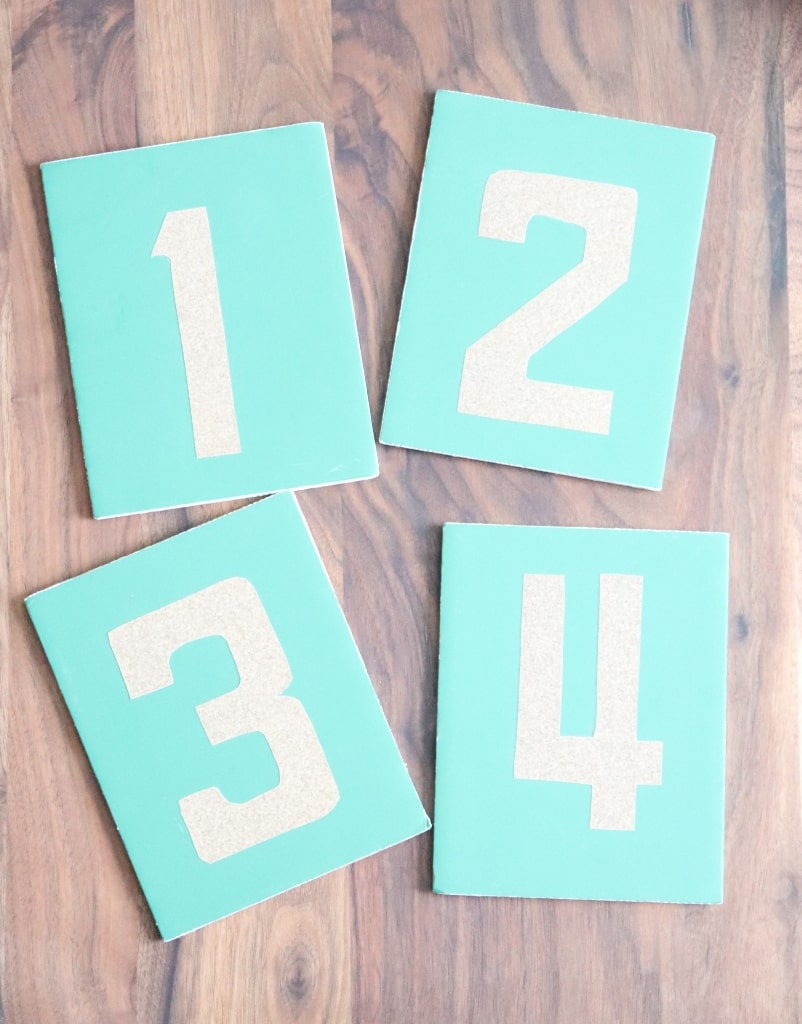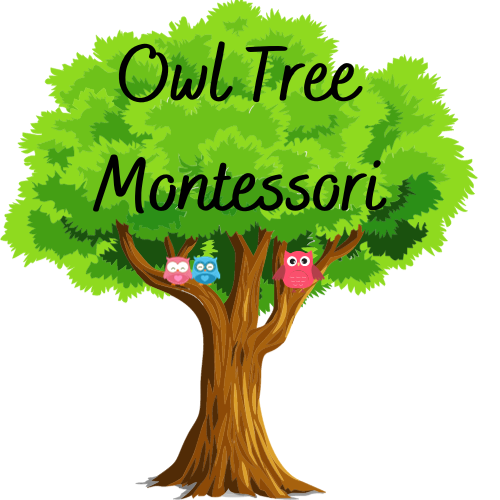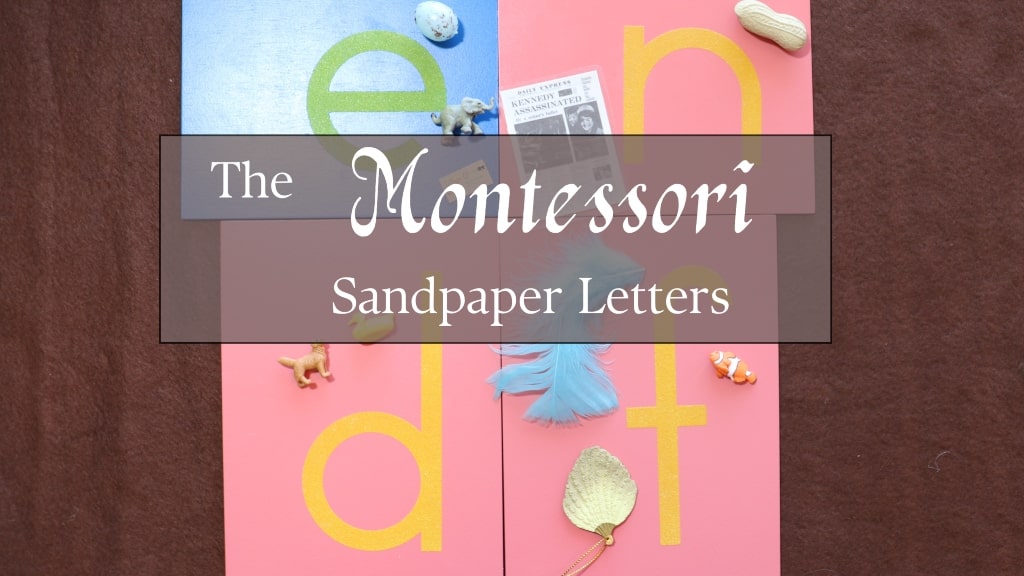The Montessori Sandpaper Letters provide children with a tactile connection between letter sounds and their written symbols. A sandpaper cutout of each letter is adhered to a wooden card. Children trace each letter with their fingers impressing the memory with both the letter sound/symbol correlation as well as proper letter formation to support handwriting practice.
Sandpaper letters can be:
Double Letter Sandpaper Letters representing digraphs (th, sh, ch) and vowel teams (oa, ee, ea) support learning non-phonetic sound/letter spelling patterns. You can choose print or cursive. These are very helpful for 2nd-3rd graders and children struggling with dyslexia.
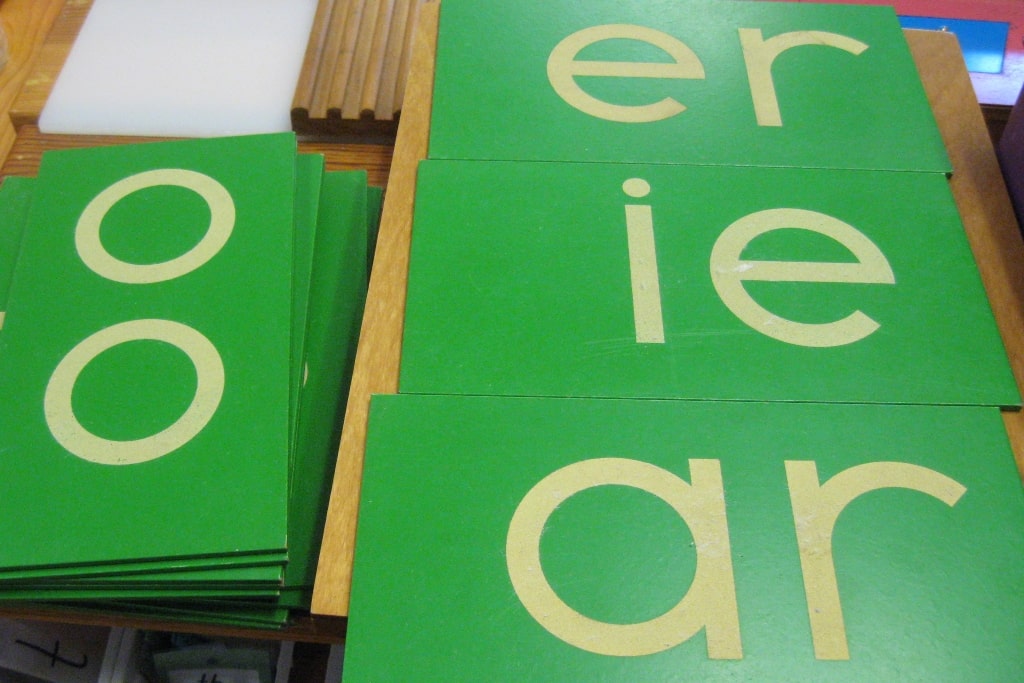
When used with Phonemic Awareness Sound Objects and the Moveable Alphabet, the Montessori Sandpaper Letters become a part of comprehensive and systematic phonics instruction.
*This post contains Amazon Affiliate links. We receive a small commission on purchases through links at no additional cost to you.
The Montessori Sandpaper Letters with Sound Objects
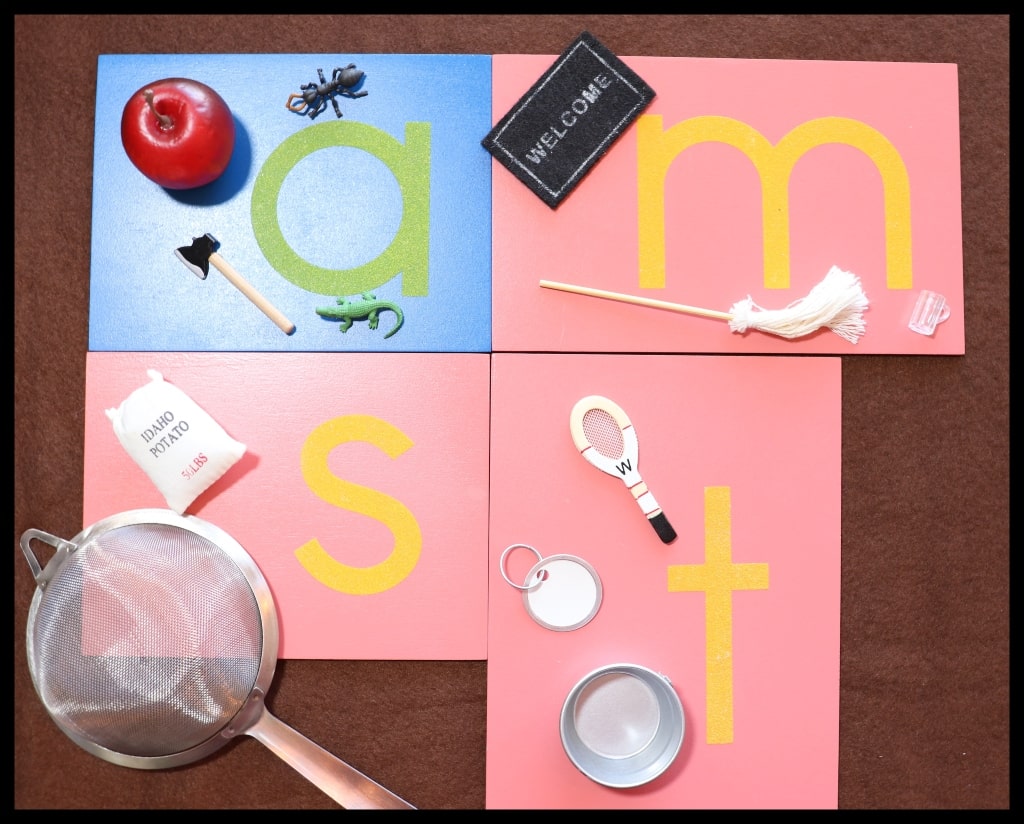
When used in conjunction with the Sound Objects (objects chosen to represent the individual sounds in words), the Montessori Sandpaper Letters create a strong connection between phonemic awareness, phonics, and letter formation resulting in meaningful learning experiences and retention. For example,
- Show children the sound object “mop” with a focus on listening to the beginning sound of the word /m/.
- Next, show them the sandpaper letter “m” and help them properly trace it while saying the sound, “mmmmm”.
The correlation of the sound object “mop” and the tactile finger tracing of the sandpaper letter “m” impresses the child’s memory.
Choose several other objects that also begin with /m/ (map, mat, mug, muffin) deepening awareness and discovery.
Sound objects with double letters like a digraph (chest, ship, bath) or a vowel team (boat, foot, teeth) can be used with corresponding Montessori Double Sandpaper Letters to teach the phonetic rule.
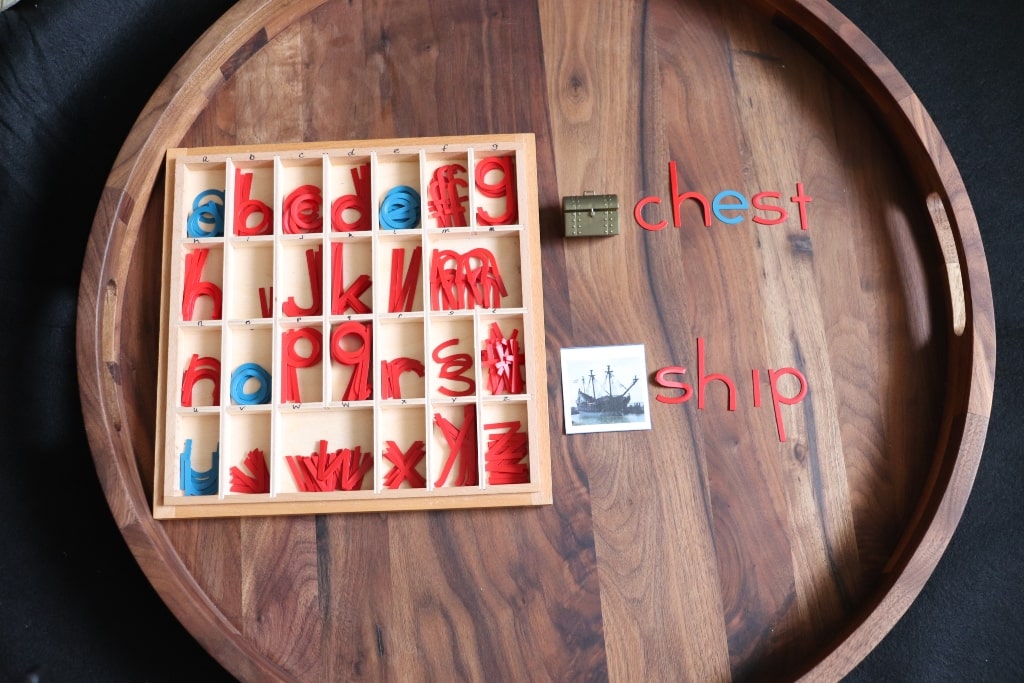
Introduction with a “Three Period Lesson”
Maria Montessori advocated introducing concepts to children using a “Three Period Lesson”. She adapted this method from physician Edouard Seguin using it to introduce concepts in every subject area including language acquisition. There are three stages to a Three Period Lesson:
Name- The importance of this stage is to simply give information by naming an object or concept. The teacher’s statement begins with, “This is…”
For example, “This is the letter m, /m/.”
Recognize- The importance of this stage is to help children recognize the taught object or concept. Spend the most time with this step making a game of naming, locating, or matching objects and concepts. The teacher’s statement begins with, “Show me…”
For example, “Show me the letter m /m/.”
Spend time moving the letter “m” around on the work surface, placing other letters beside “m”, asking children to show you the letter “m” in a workbook page, from the moveable alphabet box, or a collection of magnetic letters.
Recall- The importance of this stage is to assess the recall of an object or concept. The teacher’s question is, “What is this?”
For example, point to the letter “m” and ask, “What letter is this? What sound does it make?”
The “Knock-Knock” Game
A fun recall game with the sandpaper letters is called the “Knock-Knock” Game. Children play the “Knock, knock” game by turning a Sandpaper Letter face down, knocking on the letter, turning it over, and saying the sound the letter makes while tracing it.
- Turn the Sandpaper Letter “m” face down.
- Knock on the back of the letter saying, “Knock, knock. Who’s there?”
- Flip the letter over and see if the child can remember the sound the letter makes.
- Include three or four different letters together in a set to make a fun recall guessing game!
The “Knock Knock” game can be used with Double Letter Sandpaper Letters (th, oo, ie, etc.) in the same way to practice non-phonetic spelling patterns and support reading skills.
Independent Work with a Sand Tray
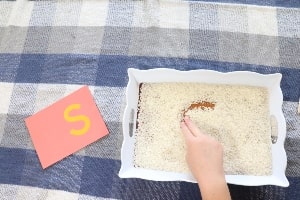
Fill a small tray with sand (or rice) for children to trace the letter they are learning. This activity becomes an extension work with an added degree of complexity. The child now writes the letter symbol freeform in sand practicing its sound and proper formation.
- Trace the Montessori Sandpaper Letter or Double Sandpaper Letters.
- Write the letter or vowel team in the sand or rice on the tray.
- Say the sound the letter (s) makes.
- Shake the tray to erase.
The Moveable Alphabet
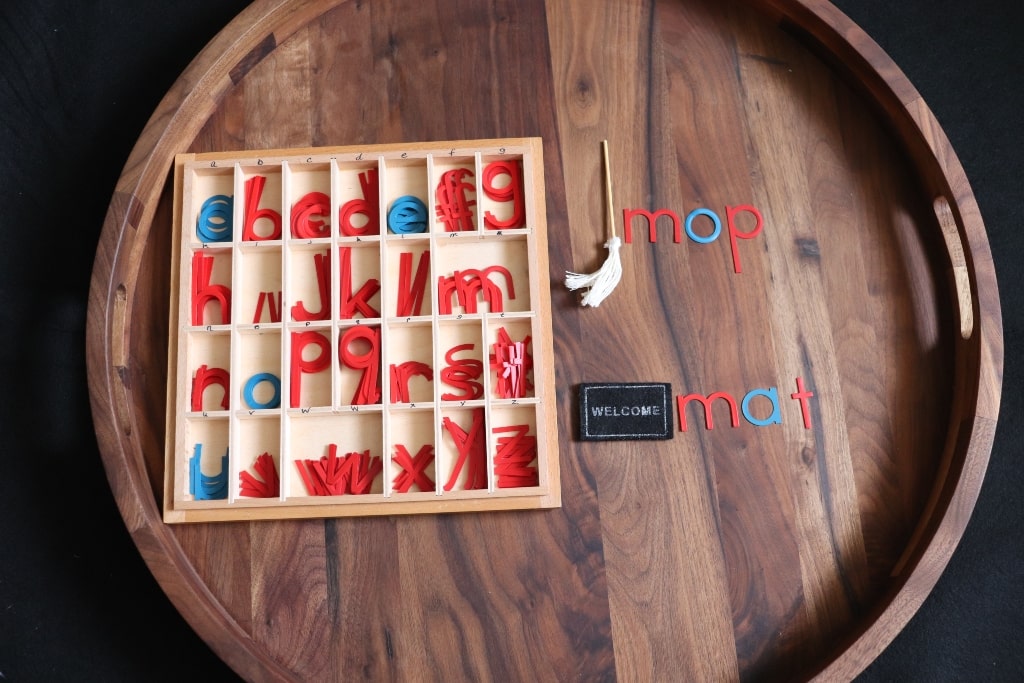
Once your child masters a handful of letters and their sounds, he/she uses the Movable Alphabet to build words and read them. For example, show your child the “mat” object, or a picture of a mat. Ask your child to listen to the beginning sound in the word mat. Next ask your child to find the letter “m” in the box and place it next to the object or picture.
If your child has been introduced to identifying ending and middle sounds, ask them to listen to the middle sound /a/ and the ending sound /t/, placing the letters from the moveable alphabet box next to the object or picture to form the word “mat”. Finally, your child blends the letter sounds from left to right to read the word, “mat.”
The same process is repeated with the Double Letters: Digraphs and vowel teams.
Manuscript and Cursive Handwriting Practice
The Print and Cursive Sandpaper Letters support handwriting practice through proper letter formation. Teaching a child where to start and finish a letter properly is a big part of lower elementary school.
Manuscript
The Montessori Print Sandpaper Letters assist in teaching a child to start at the top, where to pick up and start again, and where to finish the letter. They do this using fingers, wrist, and whole arm movements improving memory recall. Children practice independently tracing the letters, matching the symbols to sound objects, and tracing the letters freeform in sand or rice trays.
Manuscript print practice books support the handwriting skill after a multi-sensory introduction and when they have the fine motor skills to hold a pencil. I have used the Manuscript Sandpaper Letters to re-teach letters to children when I see they are not forming a letter correctly in the practice book.
My favorite Manuscript handwriting practice books are from Handwriting Without Tears.
Cursive
The Montessori Cursive Sandpaper Letters assist in teaching children proper letter formation of upper and lower case cursive letters. The cursive letter tactile introduction using fingers, wrist, and whole arm movements improves memory recall. Independently, children trace the sandpaper letters and trace the letters freeform in sand or rice trays.
Cursive handwriting practice books support the handwriting skill. I’ve seen more interest and success in practice books after an introduction with Cursive Sandpaper Letters. I also use the Cursive Sandpaper Letters to re-teach when I see a child is not forming a letter correctly in the practice book or is feeling frustrated.
My favorite cursive handwriting practice books are from Universal.
DIY Montessori Sandpaper Letters
The Montessori Sandpaper Letters are not very expensive, but if you have the time and resourcefulness, you can save some money by making them yourself.
I made a set of capital print letters using felt letter stickers I found at the dollar store. My husband cut wooden cards, and I stuck each letter on a card for my daughter to trace with her fingers when learning the capital letters.

I made a set of Montessori Sandpaper Numbers (shown below) for my daughter during her preschool years. I went to a hardware store to purchase sandpaper and number stencils. I traced each number on the smooth backside of the sandpaper then cut them out. My husband cut some thick foamboard into cards and I glued each number on a card.
Similarly, you could locate print or cursive letter stencils in a font you like and trace them on the back of sandpaper. Make cards using thick cardboard, foamboard, or wood and then adhere each letter or double letter team to a card.
